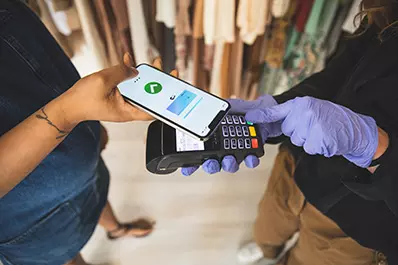Printable Version
Version imprimible en Español

In a digital economy, what are my options?
Whether it’s ordering take out from an app-based food delivery service or using a ride share app to get home, cash may not be an option for payment. More retailers are now accepting cashless payments to reduce exposure to high touch surfaces. When you are used to paying with cash, this can be challenging.
Here are some of the options available to you other than cash or traditional credit and debit cards.
Prepaid Cards
A prepaid card allows you to use a card to make purchases at stores or to pay bills online without accessing a bank account or using a credit card. These cards usually are not linked to a checking or savings account, and require you to load money onto the card up front. Find more information about FDIC deposit insurance and prepaid cards at: Is the Money on My Prepaid Card FDIC-Insured?
Here are some prepaid card types:
- Reloadable prepaid cards allow you to add money later onto the card after your initial purchase. Some cards start out as non-reloadable, but can be reloaded once you complete the issuer’s registration process. There are also prepaid cards, which are “non-reloadable,” meaning you can’t add more money onto them in the future.
- A payroll card is a prepaid card you get from your employer on which you can receive your paycheck or salary.
- A government benefit card is a prepaid card used by some government agencies to provide certain government benefits, like unemployment insurance.
- College ID cards are sometimes prepaid cards also. Some colleges offer a card that you can only use to pay for things on the school’s campus and possibly some nearby stores. Other schools offer a card that you can use at any retail location that accepts that network brand.
- Gift cards may have a network logo that allows you to use the card widely, or it may only be usable at certain retailers. While gift cards have some protections under federal law, they may not have certain protections under the Consumer Financial Protection Bureau’s (CFPB) prepaid card rules.
Visit the Consumer Financial Protection Bureau for more on Prepaid Cards.
If you already have a bank account, here are some cashless payment options and features. Ask your bank if these features are available with your account type.
Mobile Banking Technology
Banking technology and services provide the convenience of conducting banking transactions with your computer, smartphone, or mobile computer device. If you aren’t using these services, ask your bank if the following are available to you and how you can activate them.
Money transfer services: Person-to-person payment services and mobile payment apps have become part of everyday life for many people. Payment services and apps let you send money to people without having to write a check, swipe a card, or give them cash.
Online bill pay or ebill services: These programs generally allow you to sign up on your bank’s website to pay your bills electronically. You may also be able to receive bills electronically.
Contactless payments: Often referred to as tap-and-go by banks and retailers, contactless payments are a secure method for consumers to purchase products or services using a debit, credit, or smartcard (chip card) by using radio frequency identification (RFID) technology or near-field communication (NFC). To make a contactless payment at a store, tap your card near a point-of-sale terminal that is equipped with the contactless payment technology.
You can find additional tips on mobile banking technology by visiting: Banking at the Speed of Technology.
Safety Tips for a Digital Economy
Pay attention to your purchases. Be sure to monitor your credit card bills and bank statements, as well as app and other online transactions for unauthorized purchases or withdrawals. Immediately contact your bank if you see anything suspicious.
Consider signing up for alert services. Many credit card issuers, banks, and mobile app providers offer services that notify you about certain account activities, such as recent logins from unrecognized devices. Most banks that offer mobile banking, also allow you to sign up for alerts on your mobile device or email to notify you if your account balance drops below a set dollar amount. This can help you avoid overdrawing your account. You might also be able to request text alerts, if your bank observes suspicious or potentially fraudulent transactions involving your account. Some banks even let you set spending limit alerts to help keep track of your spending.
Protect yourself from scams. Scammers often create fake websites or apps that are so similar to those of popular retailers; it easily tricks consumers into providing payment information. The scammers take your information and your money, but you never receive the products. Be sure to deal with reputable companies you are familiar with to help avoid encounters with these types of scams.
If you do not have a bank account, FDIC's BankFind tool allows you to locate FDIC-insured banking institutions in your area. In addition to websites for individual banks, a few organizations have compiled lists of banks offering accounts that can be opened online:
Additional Resources:
- Save, Organize, and Streamline Your Finances (FDIC)
- Helpful tips for using mobile payment services and avoiding risky mistakes (CFPB)
For more help or information, go to FDIC.gov or call the FDIC toll-free at 1-877-ASK-FDIC (1-877-275-3342). Please send your story ideas or comments to ConsumerNews@fdic.gov
